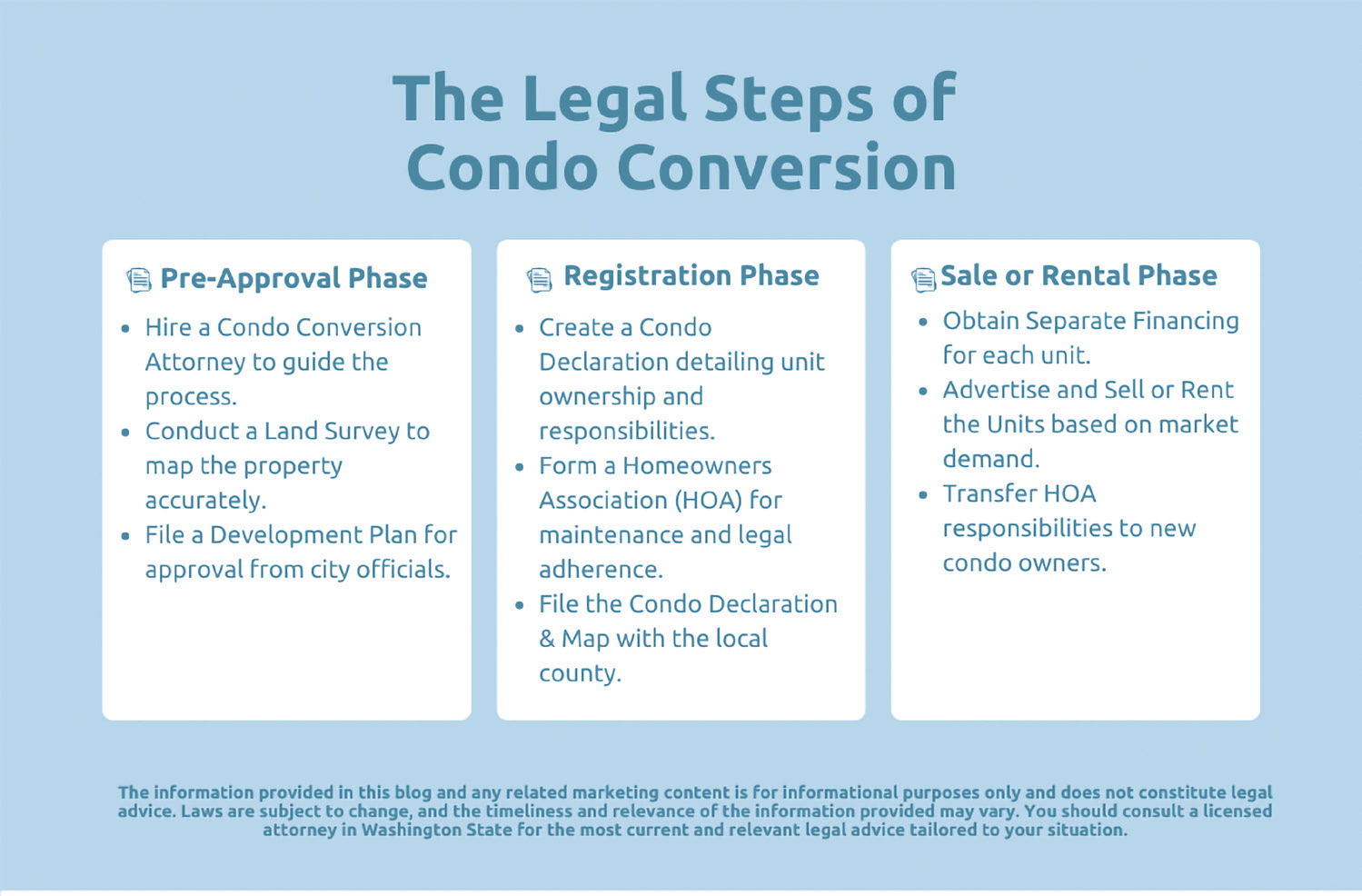Unlocking the Potential of Your Property: How to Subdivide, Build, and Convert Accessory Dwellings into Condominiums in Washington State
The condo conversion process in Washington is becoming an increasingly popular strategy for property owners and real estate developers seeking to maximize their investments. With housing demand on the rise, converting properties into condominiums through Accessory Dwelling Units (ADUs) and Detached Accessory Dwelling Units (DADUs) offers significant financial benefits. This strategy allows owners to create separate properties with their own loans, providing opportunities for rental income or even selling individual units. Whether you’re a homeowner with a spacious lot or a real estate developer looking to optimize your portfolio, converting your property into condominiums can be a game-changer.
What is Condominium Conversion?
Condominium conversion refers to the process of dividing a property into separate, legally independent units that can be sold and owned individually. For many property owners, this can be an excellent way to increase the value of their land. When combined with the construction of ADUs or DADUs, condominium conversion allows for the creation of multiple, fully independent living spaces that can be sold or rented out. The ability to convert property into condominiums is especially appealing in urban areas where space is at a premium and zoning laws have become more flexible. With the right approach, both homeowners and developers can tap into the financial benefits of creating separate condo units on the same piece of land.
Why Build an ADU or DADU?
Building an ADU or DADU on your property provides several financial and lifestyle benefits:
-
Rental Income: A separate dwelling unit can provide a steady stream of rental income, making it easier to pay off existing loans or generate additional cash flow. This is especially attractive in high-demand rental markets like Seattle.
-
Increased Property Value: Adding an ADU or DADU to your property not only increases the overall value of your land but can also make it more appealing to buyers. A property with multiple units offers greater flexibility and potential for returns.
-
Multi-Generational Living: For homeowners looking to accommodate extended family members, an ADU can be the perfect solution. It allows for proximity while maintaining privacy and independence for all parties.
-
Future-Proofing: As housing demand grows, properties that offer multiple living spaces are likely to continue increasing in value. Building an ADU or DADU now ensures your property remains competitive in the future.
The Building Permit Process: Step by Step
For both individual property owners and developers, getting approved building permits for an ADU is the first step toward creating independent units. Here’s a breakdown of the process:
-
Check Local Zoning Laws: Before anything else, it’s essential to review the local zoning regulations in your area. Washington State has specific guidelines for building ADUs. You’ll need to ensure your lot meets the minimum size requirements and that the proposed development complies with local City and/or County ordinances.
-
Obtain Necessary Permits: Getting building permits and building new structures requires approval from the local jurisdiction. Be prepared to submit detailed plans to your local planning department, including architectural designs, engineering reports, and utility plans.
-
Survey the Property: A land survey ensures accurate boundaries for each new unit. The surveyor will prepare the topographical and boundary survey map, which establishes where property lines are and ensures compliance with setback requirements and other zoning restrictions. (The survey is required in many jurisdictions, but not all.) This is especially important when building DADUs, as they are often placed in a yard and are detached from the main house.
-
Utility Planning: Each new unit will need access to utilities such as water, electricity, and sewage. In many cases, you can extend the existing utilities from the primary home, but in others, you may need to create independent connections for each unit.
-
Final Building Permit Approval: Once your plans are in order and the property has been surveyed, you’ll need to go through the permit approval process with the jurisdiction, and they will review and either approve or request changes. You can expect around 2-4 rounds of submittals and corrections before your permits are approved, but it varies by jurisdiction. It takes anywhere from 1-12 months to get approved permits, depending on what is being permitted, and whether or not you’re using pre-approved plans (which are offered by some jurisdictions).
Converting the Property: Turning Your Houses into Separate Condominium Units
Once your ADU or DADU has been permitted, the next step is to convert the property into condominiums. Approved permits and/or completed construction are not typically required to be before you record the condominium, so it’s important to speak with an experienced attorney to determine what is required for your project. Condominium conversion transforms the units into legal condominium units that can be sold separately, each with its own title and loan. Here’s how the process works:
-
Find an Experienced Condominium Attorney: To begin, you’ll need to find an attorney. It’s important to work with an attorney who has experience with creating condominium units.
-
Draft the Condominium Declaration: The attorney will work with you to draft the condominium declaration. This legal document lays out the division of the property into individual units and defines the responsibilities of each unit owner. The declaration will establish the rights of the owner of each unit.
-
Create the Condominium Map: You will need to work with a surveyor who will create the condo map, which will define the units, yards, parking, driveways, etc. Often, people use the same surveyor who did the boundary survey that was needed for the building permits. Your attorney should assist with this process to ensure the map meets all the legal requirements.
-
Establish a Homeowners Association (HOA): All condominiums require an HOA. The HOA is responsible for managing the Common Elements (shared spaces) and has certain responsibilities. Sometimes, these include utilities and exterior maintenance. While HOAs can seem daunting, they are necessary for ensuring the smooth operation of condo properties. Your attorney will assist in getting the HOA incorporated, as well as getting it transferred to the new owners if you sell any of the units.
-
Record the Condominium Declaration & Map: Once you and your attorney have finalized the declaration and the condominium map, they get recorded with the County. Some counties require review of the condominium documents.
-
Obtain Separate Financing: One of the primary benefits of condominium conversion is the ability to secure separate loans for each unit. This allows homeowners and developers to finance each unit independently, which is especially useful if you plan to sell or rent one or more of the units.
-
Sell or Rent the Units: Once the units are officially designated as condominium units, you can sell them individually or rent them out. For homeowners, this can be an excellent way to generate passive income, while developers can capitalize on the opportunity to sell multiple units on a single property.
The Legal Side: Why You Need Expert Guidance
While the idea of building ADUs and recording a condominium on your property is appealing, it’s essential to understand the legal complexities involved. From zoning regulations to creating a condominium declaration, the process can be overwhelming without proper legal guidance. This is where Dimension Law Group comes in. Specializing in land use and real estate law, Dimension Law Group has extensive experience helping individual homeowners and real estate developers navigate the condominium process. Our team can assist with everything from drafting legal documents, working with the surveyor to create the condo map, and ensuring compliance with local and state regulations.
Conclusion: Maximize Your Property’s Potential
Whether you’re a homeowner looking to create an additional source of income or a real estate developer seeking to maximize your investment, building ADUs and converting your property into condominiums offers a unique opportunity to unlock its full potential. By following the steps outlined above, you can create multiple independent units, each with the flexibility to rent or sell, all while boosting your property’s value. With the right planning, legal support, and a focus on future growth, converting your property into condominiums can be the key to financial success. For expert guidance on navigating this process, contact Dimension Law Group today and take the first step toward transforming your property.
Learn more by attending Katy Sweeden’s class on Wednesday, April 9 | 2-5pm | CRE 3 clock-hours

See details on our calendar page 4 and register at rhawa.org/events

